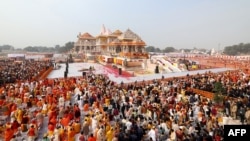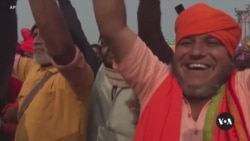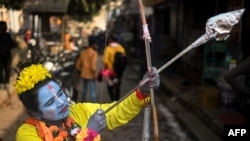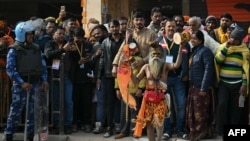Amid rituals conducted by Hindu priests, Indian Prime Minister Narendra Modi opened a grand temple built in the northern town of Ayodhya in honor of one of Hinduism’s most revered gods, Lord Rama.
The ornate, pink sandstone temple has risen on the site of a 16th century, Mughal-era mosque that was destroyed by Hindu mobs three decades ago.
“Our god Ram has come. Centuries of sacrifice and patience has paid off,” Modi told a massive crowd after the black stone idol of Lord Ram was unveiled. He said that January 22 “brings the dawn of a new era.”
The inauguration of the flower-bedecked Ram Mandir that sprawls over three hectares fulfils a pledge by Modi’s Bharatiya Janata Party, which led a decades-long movement to build the temple on the site of the mosque, which Hindus believe was built on the ruins of a temple that marked the birthplace of Lord Ram.
But for many Muslims, the temple is a reminder of the destruction of the mosque.
In December 1992, a huge mob of Hindu right-wing activists used hammers, axes and bare hands to demolish the mosque, sparking nationwide religious riots that killed nearly 2,000 people. It was the worst communal violence witnessed in India since its independence.
The religious event was showcased as one of historic and national importance in the Hindu majority country.
Among the more than 7,000 people who witnessed the ceremony, telecast on a giant screen outside the temple in the small town, were top politicians, billionaire tycoons and Bollywood stars. Air force helicopters showered flowers on the temple. The federal government declared a half day holiday.
In Ayodhya devotees beat drums and danced as loudspeakers played devotional songs. In cities, towns and villages, where excitement had been building for weeks, many lit earthen lamps as they heeded calls by Modi to celebrate the day like the biggest Hindu festival, Diwali. Saffron flags depicting Lord Ram fluttered outside many homes and shops. Millions watched the telecast of the ceremony in their homes.
However, some leading Hindu religious seers declined to attend, saying that it was against Hinduism to perform rituals in the temple since part of its construction has still to be completed.
Most opposition parties also stayed away, accusing the Prime Minister of using the temple’s inauguration for political gain. Congress Party leader, Rahul Gandhi, called it a "completely political Narendra Modi function."
Ahead of the temple’s consecration, Modi embarked on an 11-day Hindu purification ritual that included fasting and visiting temples across the country. He presided over the religious ceremony.
Critics have accused Modi of blurring lines between religion and the state in the country with a secular constitution.
“The temple is being promoted by Modi as a highpoint in India’s civilizational history,” according to political analyst Rasheed Kidwai. “The BJP makes no pretensions that the religious concerns of the majority Hindu community are on top of their political agenda.”
In the 1990’s, the campaign to build the temple stirred up Hindu nationalism and catapulted the BJP, which until then was a marginal political party, into a dominant political force.
The mood was upbeat among many Hindus as the $217 million temple opened. Many said that seeing the 1.3 meter tall black stone sculpture of Lord Ram being unveiled in the temple was an emotional moment. “I am really happy. It is a matter of faith for me,” said Nitin Kumar in New Delhi.
The ornate temple, which stretches across a 28-hectare complex, has risen on a religious site that marked one of the most bitter disputes between Hindus and Muslims, who make up India’s largest minority.
“Very systematically, Babri Masjid has been taken away from Indian Muslims. Had the Masjid not been demolished in 1992, we wouldn't have to see things how they are today," Asaduddin Owaisi, head of the Muslim party All India Majlis-e-Ittehadul Muslimeen, and a member of parliament said Saturday.
Following a decades-long court battle over the site’s ownership between Hindu and Muslim groups, the Supreme Court granted the site to Hindus in 2019 even as it called the mosque’s destruction “an egregious violation of the rule of law.” A year later, Modi laid the foundation stone of the temple.
The BJP and right-wing Hindu groups are portraying the rise of the temple as a moment of Hindu awakening following centuries of domination by Muslim and colonial powers, say analysts.
“After decades of fight and struggle, this is being presented as a victory, a victory ceremony with Modi as the head of it,” according to author and political analyst, Nilanjan Mukhopadhyay, who called the temple a symbol of the “politics of revenge and triumph.”
The spotlight on the grand new temple, ahead of national elections that are expected to begin in April, is likely to give momentum to the party’s campaign. Modi rose to power in 2014 on the pledge of development, but he has also pushed what some commentators call a “Hindu first” agenda during his two terms in office.
“The fact that Modi has been in power for ten years could have led to some dip in support. That deficit could be bridged or topped-up with the inauguration of the temple, especially in North India, where the party has a strong support base,” according to political analyst, Sandeep Shastri.
Critics have raised questions whether the prime minister’s high-profile participation in a religious ceremony undermined the multicultural ethos on which India was founded.
“The BJP calls this a moment of national rejuvenation. But this rejuvenation is going to be singular in character, not reflecting the pluralistic nature of Indian society and the Indian state’s commitment to it when we became independent,” according to Mukhopadhyay.










